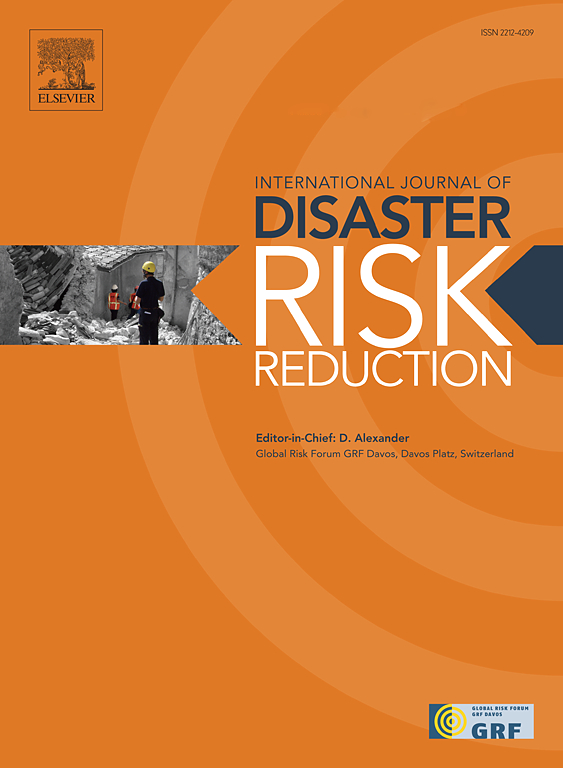Identifying social vulnerability profiles for coastal flood using supervised and unsupervised machine learning: A case study of Lekki Peninsula, Lagos, Nigeria
IF 4.5
1区 地球科学
Q1 GEOSCIENCES, MULTIDISCIPLINARY
International journal of disaster risk reduction
Pub Date : 2025-07-08
DOI:10.1016/j.ijdrr.2025.105693
引用次数: 0
Abstract
Coastal flooding disproportionately impacts households based on pre-existing vulnerability characteristics. Identifying these vulnerabilities is critical for effective flood risk reduction. Despite its significance, there is a paucity of techniques for identifying suitable Social Vulnerability Indicators at a local scale. This study investigates an evidence-based indicator approach to rank factors contributing to social vulnerability to coastal flooding using a purposive sample of 1334 flood-affected households in Lekki Peninsula, Nigeria. By integrating the Expectation Maximization Algorithm with Support Vector Regression (EM-SVR), and employing permutation feature importance, we identified distinct social vulnerability clusters and their associated indicator profiles. The findings reveal that a substantial (over 60 %) of the case study had moderate level of vulnerability, with clusters of similar rankings exhibiting variations in indicator profiles. Also, significant differences within the wards were observed across all areas, especially in Ajiran/Osapa and Maroko/Okun Alfa. The EM-SVR models were evaluated using various metrics, which revealed that the EM-SVR achieved a high R-squared accuracy across the seven clusters, ranging from 88.8 % to 95.7 % for the training set and 90.2 %–96.1 % for the testing set. Furthermore, the models demonstrated a low Mean Absolute Error, ranging from 0.051 to 0.075 for training and 0.051 to 0.077 for testing. Financial instability, poor social networks, lack of insurance, and pre-existing health conditions consistently emerged as the most influential indicators across clusters. These findings offer actionable insight for decision-makers by providing a well-structured and targeted approach to identifying vulnerable households and enhancing mitigation strategies.

利用监督和无监督机器学习识别沿海洪水的社会脆弱性概况:以尼日利亚拉各斯Lekki半岛为例
沿海洪水对家庭的影响与先前存在的脆弱性特征不成比例。识别这些脆弱性对于有效减少洪水风险至关重要。尽管其意义重大,但缺乏在地方范围内确定适当的社会脆弱性指标的技术。本研究以尼日利亚Lekki半岛1334个受洪水影响的家庭为样本,采用循证指标方法对导致沿海洪水社会脆弱性的因素进行排名。通过将期望最大化算法与支持向量回归(EM-SVR)相结合,并采用排列特征重要性,我们确定了不同的社会脆弱性集群及其相关指标概况。研究结果显示,大量(超过60%)的案例研究具有中等程度的脆弱性,类似排名的集群显示出指标概况的变化。此外,在所有地区,特别是在Ajiran/Osapa和Maroko/Okun Alfa,观察到病房内的显着差异。EM-SVR模型使用各种指标进行评估,结果表明EM-SVR在7个聚类中获得了很高的r方精度,训练集的r方精度为88.8%至95.7%,测试集的r方精度为90.2%至96.1%。此外,模型显示出较低的平均绝对误差,训练的范围为0.051至0.075,测试的范围为0.051至0.077。金融不稳定、不良的社会网络、缺乏保险和已有的健康状况一直是整个集群中最具影响力的指标。这些发现为决策者提供了一种结构良好和有针对性的方法,以确定弱势家庭并加强减灾战略,从而为决策者提供了可行的见解。
本文章由计算机程序翻译,如有差异,请以英文原文为准。
求助全文
约1分钟内获得全文
求助全文
来源期刊

International journal of disaster risk reduction
GEOSCIENCES, MULTIDISCIPLINARYMETEOROLOGY-METEOROLOGY & ATMOSPHERIC SCIENCES
CiteScore
8.70
自引率
18.00%
发文量
688
审稿时长
79 days
期刊介绍:
The International Journal of Disaster Risk Reduction (IJDRR) is the journal for researchers, policymakers and practitioners across diverse disciplines: earth sciences and their implications; environmental sciences; engineering; urban studies; geography; and the social sciences. IJDRR publishes fundamental and applied research, critical reviews, policy papers and case studies with a particular focus on multi-disciplinary research that aims to reduce the impact of natural, technological, social and intentional disasters. IJDRR stimulates exchange of ideas and knowledge transfer on disaster research, mitigation, adaptation, prevention and risk reduction at all geographical scales: local, national and international.
Key topics:-
-multifaceted disaster and cascading disasters
-the development of disaster risk reduction strategies and techniques
-discussion and development of effective warning and educational systems for risk management at all levels
-disasters associated with climate change
-vulnerability analysis and vulnerability trends
-emerging risks
-resilience against disasters.
The journal particularly encourages papers that approach risk from a multi-disciplinary perspective.
 求助内容:
求助内容: 应助结果提醒方式:
应助结果提醒方式:


